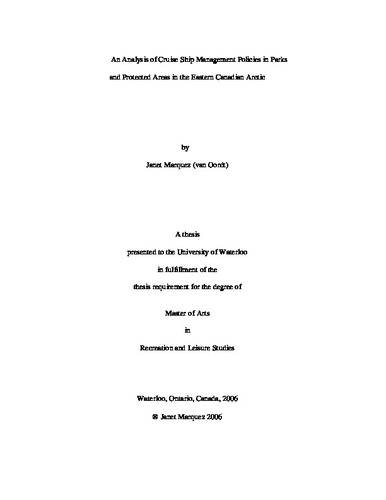| dc.contributor.author | Marquez, Janet | en |
| dc.date.accessioned | 2007-05-08 13:36:12 (GMT) | |
| dc.date.available | 2007-05-08 13:36:12 (GMT) | |
| dc.date.issued | 2006 | en |
| dc.date.submitted | 2006 | en |
| dc.identifier.uri | http://hdl.handle.net/10012/2799 | |
| dc.description.abstract | This study establishes an initial understanding of the state of cruise tourism in the Eastern Canadian Arctic. Two specific objectives were fulfilled; a) to develop an understanding of the goals and operational procedures of current cruise ship operators, and b) to provide insight into the policies that may be necessary for Parks Canada and the Canadian Wildlife Service to enhance management in parks and protected areas. <br /><br /> Cruise tourism in the Eastern Canadian Arctic is a relatively new industry. At present, there is a lack of inclusive government guidelines for the Canadian cruise tourism industry. The steady increase of cruise tourism traffic in the region since 1984 suggests the potential for environmental and social impacts to this fragile polar region. There is a need for the creation of guidelines to direct this tourism activity. <br /><br /> A literature review identified the current state of the cruise line industry in the Eastern Canadian Arctic, Antarctic and Alaskan waters. The policy requirements pertaining to cruise tourism in parks and protected areas were identified including the current management strategies for tourism employed in Northern Canadian parks and protected areas. <br /><br /> Content analysis of current cruise tourism literature themes, which were used to create and conduct interviews that explored these themes. From these findings, data was used to create a policy formation framework that will assist in the planning and management of cruise tourism in the Eastern Canadian Arctic. <br /><br /> The results indicated that cruise tourism in the Eastern Canadian Arctic is percevied as a safe and economically viable industry. The research found a high degree of coherence between the literature and the opinion of the stakeholders in regards to key issues that need to be addressed. Such issues include the need for greater academic research on this topic; the need for policies and guidelines to aid in the management of parks and protected areas in polar regions; a need for unity and cohesion in the Arctic Cruise Tourism Industry and finally, greater government awareness and assistance given to the cruise tourism industry in the Eastern Canadian Arctic. There was also a high degree of enthusiasm from the stakeholders for inter-group and interagency cooperation. This enthusiasm bodes well for the future of cruise tourism policy creation in the Eastern Canadian Arctic. <br /><br /> This thesis proposes a structure for the way forward. | en |
| dc.format | application/pdf | en |
| dc.format.extent | 3139113 bytes | |
| dc.format.mimetype | application/pdf | |
| dc.language.iso | en | en |
| dc.publisher | University of Waterloo | en |
| dc.rights | Copyright: 2006,
Marquez, Janet. All rights reserved. | en |
| dc.subject | Leisure | en |
| dc.subject | Recreation & Tourism | en |
| dc.subject | Eastern Canadian Arctic cruise tourism | en |
| dc.subject | cruise tourism | en |
| dc.subject | sustainable tourism in polar regions | en |
| dc.subject | Arctic cruise ship operators | en |
| dc.subject | policy formation framework | en |
| dc.subject | cruise tourism policy creation | en |
| dc.subject | cruise tourism in parks and protected areas. | en |
| dc.title | An Analysis of Cruise Ship Management Policies in Parks and Protected Areas in the Eastern Canadian Arctic | en |
| dc.type | Master Thesis | en |
| dc.pending | false | en |
| uws-etd.degree.department | Recreation and Leisure Studies | en |
| uws-etd.degree | Master of Arts | en |
| uws.typeOfResource | Text | en |
| uws.peerReviewStatus | Unreviewed | en |
| uws.scholarLevel | Graduate | en |

